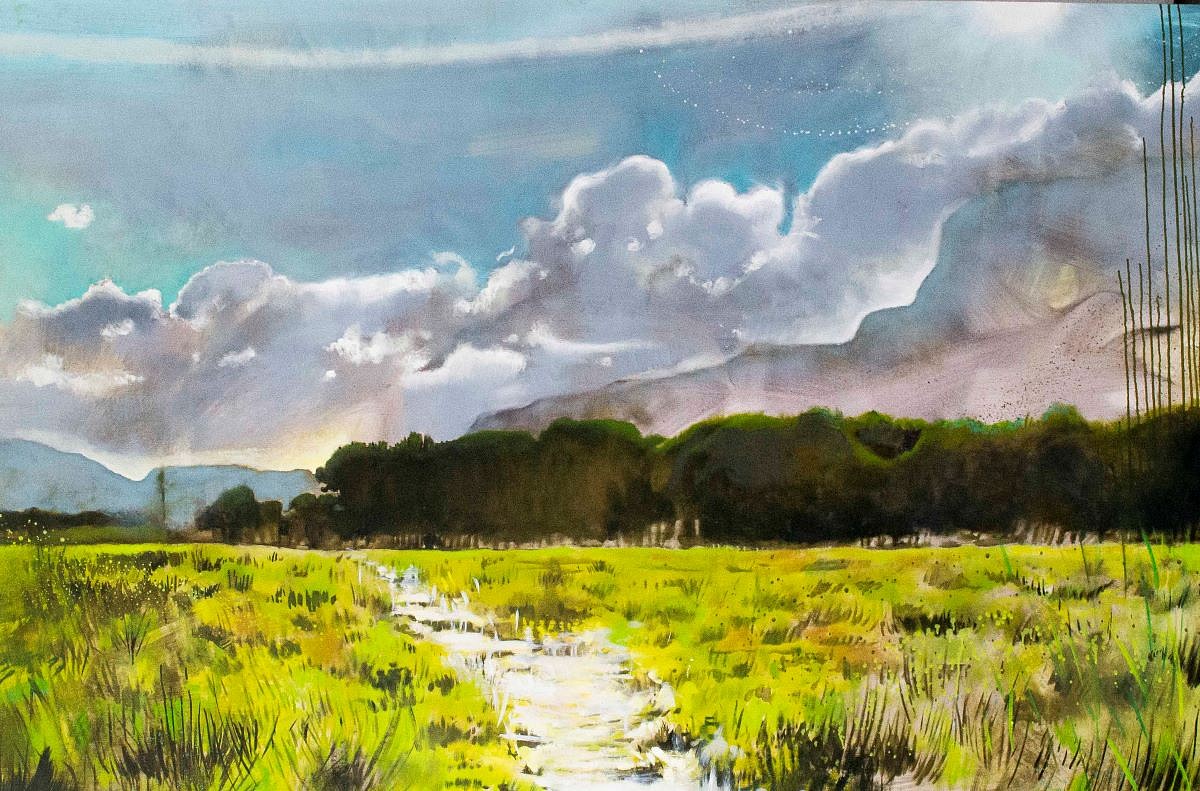PRESS RELEASE

MATTHEW HINDLEY | Memoryscapes
May 20 – Jun 18, 2023
MATTHEW HINDLEY
MEMORYSCAPES
Everard Read Franschhoek is pleased to present a new exhibition by Matthew Hindley entitled Memoryscapes.
20 May – 18 June
Everard Read at Leeu Estates
Please join us on Saturday the 20th of May at 11am to celebrate the opening of the exhibition.
To be added to the catalogue waiting list, please click HERE.
This show signals an exciting new departure for Hindley. After some years of focusing on abstract works, Memoryscapes re-introduces landscapes to his oeuvre. These include renderings of the gardens and wetlands of Leeu Estates in Franschhoek – where Hindley completed the majority of these paintings on residency – as well as landscapes of personal significance to the artist: the view from his former studio, the road where he now lives and works at dusk, the forest he and his daughter visited on holiday in Nature’s Valley.
The first of these new landscape paintings was one of the Rondebosch Common, presented at the Cape Town Art Fair. The Common is a many-layered space for Hindley. Many of his most vivid memories occurred on this patch of veld, surrounded by suburbia, beneath which there is an undercoat of history. The Commons was used as grazing ground by the Khoi, then privatised by colonial settlers; it was designated a national monument in 1960 and has since become a site of contention in land-back debates as well as environmental conservation efforts. Re-surfacing to the personal, Hindley remembers that one of the last moments he shared with his mother before she died was a drive around the Common.
I draw out these layers because they are emblematic of the thesis at the heart of Memoryscapes. That landscapes are “a construct of memory,” as historian Simon Schama writes, “a work of the mind built up as much from the strata of memory as from layers of rock.” These strata, according to another artist invested in South African landscapes, Santu Mofokeng, include “literal, colloquial, psychological, philosophical, mystical, metaphysical and metonymic meanings and applications.” But whereas Mofokeng’s black and white photographs of landscapes tended towards a language of absences, shadows and ghosts, Hindley’s landscapes are vibrant, luminous, teeming with life. Green is not just green but neon. Blue is not just blue but cerulean. Sunlight blasts through the outline of clouds. Pools of water are vivid mirrors. Occasional splatters of orange and black paint indicate that these images are meant to be expressive rather than directly representative. Or, as Hindley put it, “More feeling than what is.”
The paintings, save for one, are absent of figures. This is, I think, less so the fantasy of an untouched landscape than it is a reflection of the privacy of one’s own mind. The act of painting these scenes does not approximate the act of claiming them. Rather, these paintings exhibit an intense love for their subjects. Compare these landscapes to those by Pierneef, for example. Whereas Pierneef’s are so deliberately composed as to almost look unreal, Hindley’s landscapes exhibit a gentler attitude. The aim is not to distinguish, refine and beautify but to observe ambiguity. To surrender to the ways in which memory diffuses details into a mirage. To approach. When I ask Hindley the painters to whom he looked for guidance in the painting process, he names Van Gogh, and I am reminded of John Berger’s musings on the Dutch painter:
“He was compelled to go ever closer, to approach and approach and approach. In extremis he approaches so close that the stars in the night sky became maelstroms of light, the cypress trees ganglions of living wood responding to the energy of wind and sun. There are canvases where reality dissolves him, the painter.”
Similarly, Hindley seems to look at clouds as harbingers of messages, composed of light. Water is an ebbing life-force. Rocks are muscles flexing, and grasses tilt towards the wind. Hindley often places us, the viewers, in the middle of a stream or a road, and there is a double-movement at work here. We approach the landscape as much as the landscape approaches us. The effect is one of fusion. The boundary between self and landscape is dissolved. The gap between memory and present is closed.
This reading might seem somewhat esoteric at first, but there is a political dimension to it as well. I return to the Common – to the idea of a commons. It feels significant, to me, that many of the sites depicted – the banks of the Liesbeek River, the coastal tidal pools, the wetlands of the winelands – are some of the few truly communal spaces left in a region scarred by centuries of land privatisation and its commensurate acts of exclusion and exploitation. The beach, the river – these can be said to belong to no one and, therefore, they belong to all of us. By turning his attention to these places, Hindley nods at the histories of their enclosure (as evidenced by the dam in the Liesbeek, the rock walls of the tidal pools) and gestures towards a future in which they are ever-more at threat of ecological disaster.
When I look at these paintings, I am reminded that the earth is not just the stage upon which the human drama is performed. It sustains us. It is bigger than we are and remembers more. It does not just populate our memories, but moulds them and offers a mirror with which one can look at one’s memories anew. Perhaps the first step towards protecting the earth, the urgent task of our century, is attuning to it, observing it with humility and grace, as Hindley does.
- KEELY SHINNERS, 2023
Everard Read at Leeu Esates
Leeu Estates, Dassenberg Road, Franschhoek
Opening times: Tuesday - Sunday 10:00 - 16:00
Contact us to make an appointment outside of these hours.
erlgallery@everard.co.za
021 492 5980



